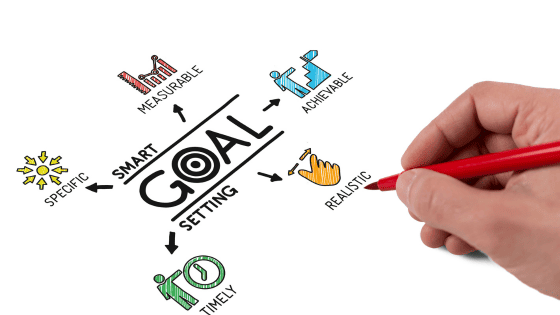How To Set A Goal You Will Achieve: 7 Science-Backed Action Steps
Setting and achieving your goals is more attainable when you understand the science behind motivation, belief, and action.
This article delves into the psychological and practical aspects of how to set a goal that not only resonates with your inner self, but will also propel you toward it’s achievement.

How To Set A Goal
While the SMART (Specific, Measurable, Achievable, Relevant, Time-bound) framework provides a solid foundation, achieving goals often requires a deeper, more introspective approach.
Here’s a breakdown of each step to goal achievement, supported by research, along with actionable tips to implement them.
Step 1: Clarify Your Goal
The first step to achieving any goal is to have a crystal-clear understanding of what it is. You need to know where you are going.
This goes beyond just being specific; it’s about knowing why this goal matters to you.
Ask yourself what achieving this goal would mean for your life. How does it align with your values and aspirations?
The clarity of purpose will be your beacon, guiding you through challenges and keeping you motivated.
Research Insight: Goal clarity is associated with higher motivation and job satisfaction, according to Locke and Latham’s goal-setting theory. Clear goals help focus attention and effort, leading to higher performance.
Action Steps:
- Write down your goal. Make it as specific as possible.
- Ask why. Identify why this goal is important to you and what it represents in your life.
- Visualize the outcome. Think about what achieving this goal looks like.
Step 2: Believe In Your Goal
Believing in the achievement of our goals is a powerful catalyst for success.
When we hold a firm belief in our ability to reach our objectives, it naturally enhances our motivation and resilience in the face of challenges.
We are less likely to give up when obstacles arise, and have a stronger sense of self-discipline. Because we trust that it will all work out.
This cycle of belief and action creates a positive feedback loop, where the more we believe in our ability to achieve our goals, the more disciplined and motivated we become, thus increasing our chances of success.
Research Insight: Bandura’s self-efficacy theory highlights the role of belief in one’s abilities in achieving goals. Higher self-efficacy correlates with naturally greater effort and resilience.
Action Steps For Building Self-Efficacy:
- Reflect on past successes. Remind yourself of times you’ve overcome challenges and achieved goals in the past.
- Start small. If self-discipline has been an issue in the past, then commit to following through on your desired action for 3 days, or even 3 hours if your current level of faith in yourself is low. Once you’ve completed your first mini target, you are essentially building trust and faith in yourself to go on and achieve more and more.
- Learn from the Success of Others: Observing others who are similar to yourself succeed in goals can also inspire and motivate you to believe in your own capabilities. Finding relatable role models can reinforce the idea that you, too, can succeed.
Step 3: Visualize Your Success
Visualization is a powerful tool in goal achievement.
By creating a vivid mental image of having already achieved your goal, you engage your subconscious mind, which helps in aligning your thoughts and actions with your goal.
Spend a few minutes each day visualizing not just the end result but also the steps you are taking to get there.
This practice can make self-discipline easier and a natural tendency to take the required actions without the need for force, motivation or willpower.
Research Insight: Studies in sports psychology show that visualization improves athletic performance. It primes the brain for success by enhancing motivation, confidence, and strategy planning.
Action Steps:
- Daily visualization. Spend a few minutes each day visualizing achieving your goal.
- Use all senses. Make the visualization as vivid and detailed as possible, involving all senses.
- Visualize the process. Imagine the steps you are taking towards the goal, not just the end result.
Step 4: Tie Your Goal to Actions
While it’s essential to have a goal, it’s equally crucial to tie that goal to specific actions.
Break down your goal into smaller, manageable tasks and set deadlines for these tasks.
This approach transforms the abstract goal into tangible steps, making the journey towards the goal seem less daunting and more structured.
Research Insight: Implementation intentions (“If-Then” plans) significantly increase the likelihood of goal achievement by linking goals to specific behaviors, as found in studies by Gollwitzer.
Action Steps:
- Break down the goal. Create a step-by-step plan with actionable tasks.
- Set deadlines. Assign realistic time frames for each task.
- Monitor progress. Keep a journal or use an app to track your progress.
Step 5: Be Consistent
Consistency is key in the journey towards goal achievement.
It’s not just about making a plan; it’s about sticking to it.
Set aside regular time for activities that move you closer to your goal. Consistency in action fosters habit formation, making it easier to maintain progress even when motivation wanes.
Research Insight: Duhigg’s research on habits shows that consistency is key to forming new habits. Regular action towards a goal helps integrate that behavior into daily routines.
Action Steps:
- Schedule time. Dedicate specific times for tasks related to your goal.
- Routine integration. Incorporate goal-related activities into your daily routines.
- Accountability partners. Share your goals with someone who can help keep you accountable.
Step 6: Adapt and Overcome
No path to a goal is without obstacles.
Being flexible and willing to adapt your strategies is crucial. When faced with challenges, reassess your approach and be open to trying new tactics.
This adaptability can make all the difference in overcoming hurdles and moving forward.
Research Insight: According to Martin Seligman’s research on learned optimism, the ability to adapt and maintain a positive outlook in the face of challenges is crucial for overcoming obstacles.
Action Steps:
- Plan for obstacles. Anticipate potential challenges and plan how to address them.
- Growth mindset. View challenges as opportunities for growth.
- Seek feedback. Regularly review your strategies and be open to making changes.
Step 7: Celebrate Progress
Finally, remember to celebrate your progress along the journey, no matter how small (see above step 2).
Acknowledging and rewarding yourself for the milestones you reach will reinforce your belief in your ability to achieve your goal and boost your motivation to continue.
Research Insight: Teresa Amabile and Steven J. Kramer’s “The Progress Principle” suggests that recognizing small wins significantly boosts inner work life and fuels further accomplishments.
Action Steps:
- Set mini-milestones. Break your goal into smaller achievements.
- Reward yourself. Create a reward system for each milestone you reach.
- Reflect on progress. Regularly take time to reflect on and appreciate the progress you’ve made.
Implementing these steps, grounded in psychological research, can significantly enhance your ability to set and achieve meaningful goals.
Remember, the journey is as important as the destination, so embrace each step and the growth it brings.
If you want more direction in what goals to set, then be sure to check out: Life Design – How To Stop Drifting.





